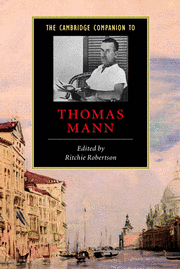Book contents
- Frontmatter
- 1 Mann and history
- 2 The intellectual world of Thomas Mann
- 3 Mann's literary techniques
- 4 Mann's man's world
- 5 Mann's early novellas
- 6 Classicism and its pitfalls
- 7 The political becomes personal
- 8 Buddenbrooks
- 9 The Magic Mountain
- 10 Religion and culture
- 11 Doctor Faustus
- 12 Lotte in Weimar
- 13 The Confessions of Felix Krull, Confidence Man
- 14 Mann as essayist
- 15 Mann as diarist
- 16 Mann in English
- Bibliography
- Index
9 - The Magic Mountain
Published online by Cambridge University Press: 28 May 2006
- Frontmatter
- 1 Mann and history
- 2 The intellectual world of Thomas Mann
- 3 Mann's literary techniques
- 4 Mann's man's world
- 5 Mann's early novellas
- 6 Classicism and its pitfalls
- 7 The political becomes personal
- 8 Buddenbrooks
- 9 The Magic Mountain
- 10 Religion and culture
- 11 Doctor Faustus
- 12 Lotte in Weimar
- 13 The Confessions of Felix Krull, Confidence Man
- 14 Mann as essayist
- 15 Mann as diarist
- 16 Mann in English
- Bibliography
- Index
Summary
In his impetuous youth, Gustav Aschenbach 'sent seed corn to the mill' (viii, 454), but such rashness pales in comparison to how Thomas Mann, writing his Venetian novella, cast most of his own store of seed corn to the winds. The enumeration of Aschenbach's achievements (viii, 450) assigns nearly all the projects in Mann's own notebooks and unfinished manuscripts to the accomplished oeuvre on which Aschenbach's fame rests. After that, visibly the same works could hardly appear in the bookstores under another author's name. The novella that depicts an aging writer's failing creativity dealt with its real author's mid-life creative crisis by forcing a clean sweep of plans which had long been engaging, but perhaps also blocking, his imaginative energies. That is the first thing that has to be recognised about the place of The Magic Mountain in Mann's literary biography: its themes and techniques emerged to fill the gap he had bravely, perhaps even desperately, created by letting Aschenbach complete his own previous plans. We, of course, now know that Buddenbrooks was not to be Mann's only work on the grand scale, but in July 1912, when Death in Venice appeared, he himself knew no such thing. What he did know was that the kind of fame he had tasted and longed to extend required more 'big' novels, and highly acclaimed ones at that, for its sustenance. He seems at first not to have anticipated that the 'novella' or 'story' which he first mentions in correspondence in the second half of 1913 as a 'humorous companion-piece' to Death in Venice would grow into one of the classic long novels of the twentieth century and would give a completely new dimension to his reputation, founding that view of him as an artist of encyclopaedic range which for the rest of his life he generally relished, though occasionally lamented.
- Type
- Chapter
- Information
- The Cambridge Companion to Thomas Mann , pp. 137 - 150Publisher: Cambridge University PressPrint publication year: 2001
- 1
- Cited by



